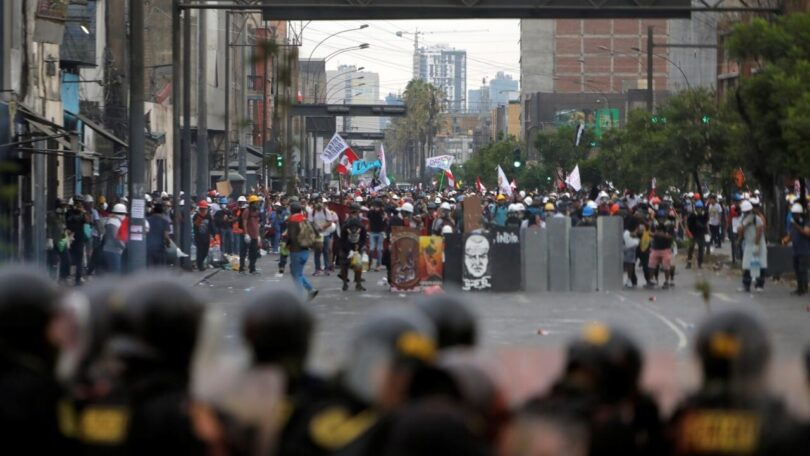LIMA (AFP/APP): Demonstrations in Lima turned fatal on Saturday as one protester died in clashes with police near Congress after lawmakers rejected a request by Peru’s embattled president to bring elections forward.
Hooded protesters wielding shields, stones and pieces of cement pried from public buildings fought with police in the fog of tear gas as Lima became the scene of scuffles and the city’s first death from the protests was recorded.
The South American country has been embroiled in a political crisis with near-daily protests since December 7, when former president Pedro Castillo was arrested after attempting to dissolve Congress and rule by decree.
In seven weeks of demonstrations, 48 people including one police officer have been killed in clashes between security forces and protesters, according to the Ombudsman’s Office of Peru. The latest violence comes after President Dina Boluarte had urged lawmakers to find a way out of a deepening political crisis by agreeing to hold elections earlier.
In the early hours of Saturday, lawmakers had rejected her request to move the polls forward to December, even as anti-Boluarte protests raging across the country have left dozens dead. “Not one more dead, Dina murderess,” marchers had chanted in what began as a peaceful and festive procession with Andean musical groups and artists, until hooded individuals arrived.
The ombudsman’s office reported the latest fatality on Twitter, saying that “we regret the death of Victor Santisteban Yacsavilca in the violent demonstrations today,” without specifying how the death had occurred.
Earlier in the week, Boluarte told reporters that she believed the groups behind the violence in the country sought “a death in Lima.”
“They say that a death in Lima is worth a hundred in the provinces,” she said Tuesday.
Demanding that Boluarte resign and call fresh elections, Castillo supporters have blocked highways, causing shortages of food, fuel and other basic supplies. The government said it will soon deploy police and soldiers to clear the roadblocks.
Boluarte on Saturday urged politicians to “put down their partisan interests and place the interests of Peru above them.”
“We regret that the Congress of the Republic has been unable to define the date of general elections where Peruvians can freely and democratically elect the new authorities,” she said on Twitter.
Lawmakers had agreed last month to bring forward elections from 2026 to April 2024.
But in the face of relentless protests, Boluarte on Friday urged Congress to move the vote up further, to December.
However, at a plenary session that ended early Saturday, Congress rejected the proposal, with 45 votes in favor, 65 against and two abstentions.
Demonstrators are calling for immediate elections, as well as Boluarte’s removal, the dissolution of Congress and a new constitution.
“Nobody has any interest in clinging to power,” Boluarte insisted on Friday. “If I am here it is because I fulfilled my constitutional responsibility.”
As Castillo’s vice president, Boluarte was constitutionally mandated to replace him after he was impeached by Congress and arrested.
The US State Department on Friday urged dialogue and restraint by all parties.
Apart from those who have died in protests, an additional 10 civilians, including two babies, died when they were unable to get medical treatment or medicine due to roadblocks, the ombudsman’s office said.
In southern regions, roadblocks have resulted in widespread shortages.
Some of the worst violence and highest death tolls have come when protesters tried to storm airports in the south.
Southern regions with large Indigenous populations have been the epicenter of the protest movement that has affected Peru’s vital tourism industry.
As well as blocking dozens of roads and forcing the temporary closure of several airports, protesters have placed rocks on the train tracks that act as the only transport access to Machu Picchu, the former Inca citadel and jewel of Peruvian tourism.
Hundreds of tourists were stranded at the archeological ruins, with many eventually evacuated by helicopter.







